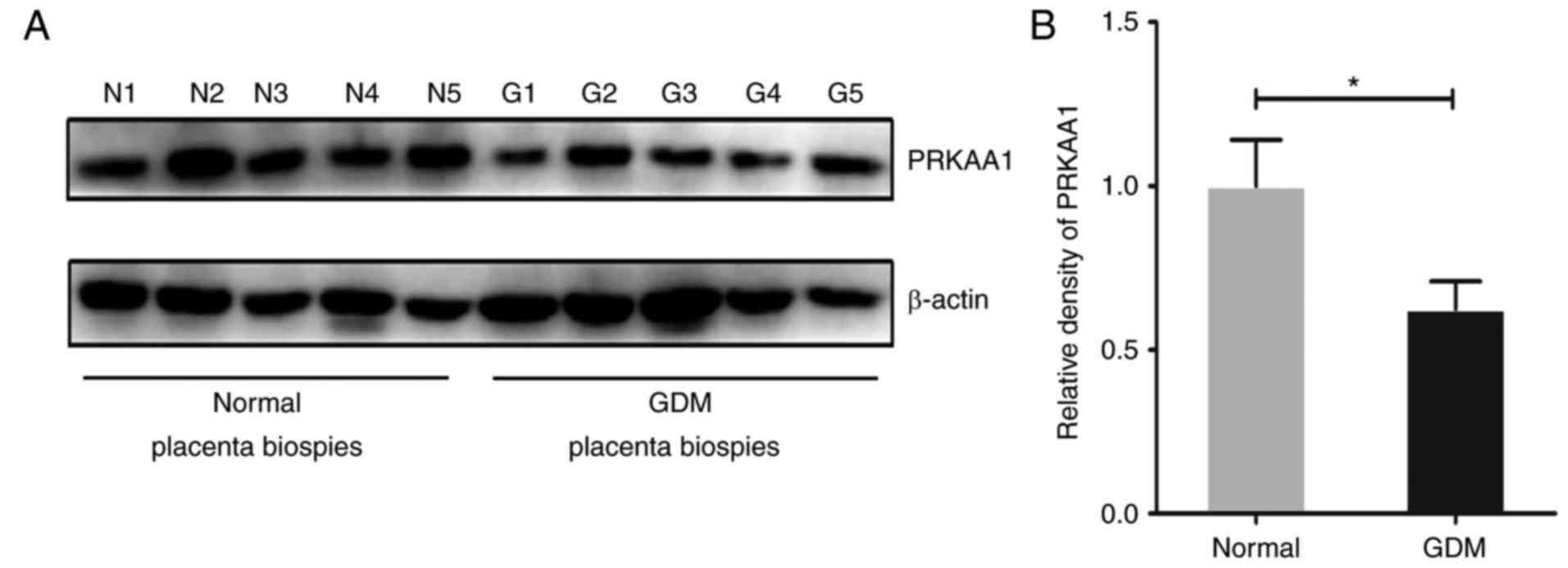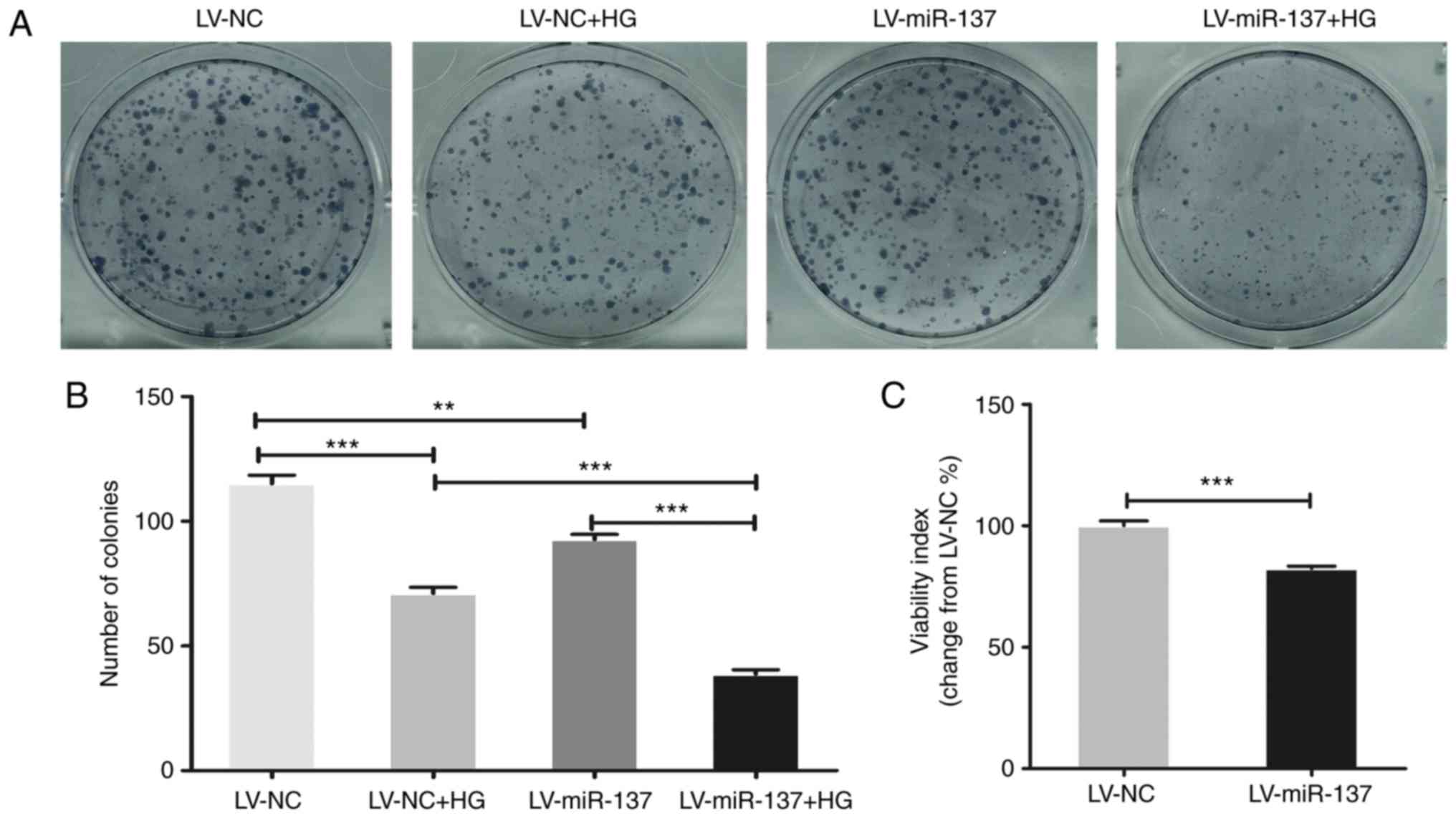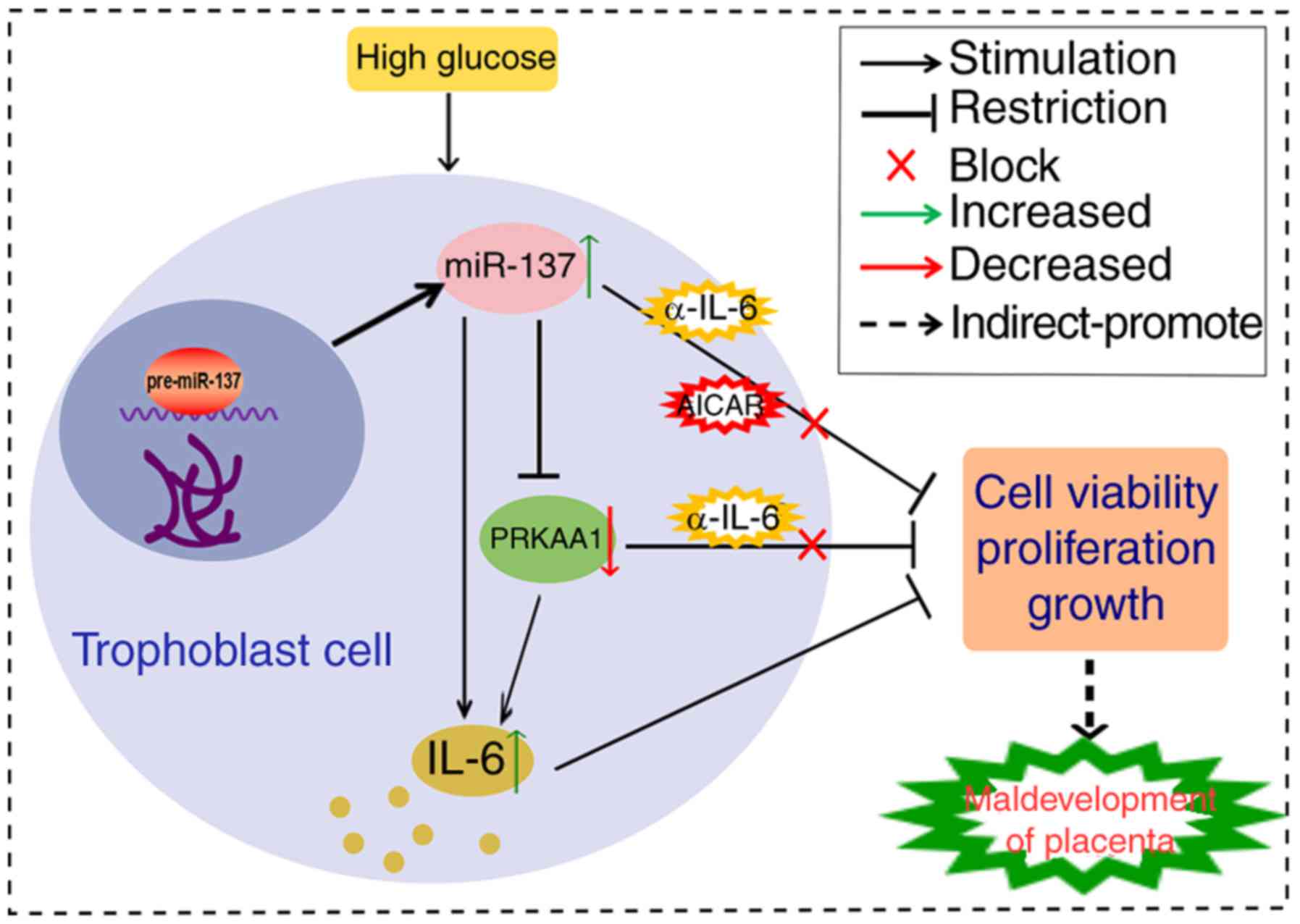Introduction
Diabetes during pregnancy refers to two conditions,
namely pre-gestational diabetes and gestational diabetes mellitus
(GDM). The former comprises diabetes prior to conception, including
type 1 diabetes mellitus and type 2 diabetes mellitus (T2DM), and
the latter refers to impaired glucose tolerance that is initiated
during pregnancy, which is the greatest contributor to cases of
diabetes during pregnancy. GDM is characterized by hyperglycemia
and disturbance of carbohydrate metabolism, and the etiology and
pathological changes may be largely different from T2DM (1). Poorly controlled GDM may result in
maldevelopment and incorrect vascular remodeling of the placenta.
Previous studies have suggested that maternal hyperglycemia at
early stages of pregnancy may facilitate abortion and fetus
malformation, in addition to abnormal development of the first
trimester placental tissue (2,3),
which may be ascribed to the effect of high glucose (HG) on the
placenta. As a crucial organ for nutrition exchange between mother
and fetus during pregnancy, the regular formation, implantation and
growth of the placenta are important to assure healthy pregnancy
maintenance and embryonic development (4). Trophoblast cells of normal
biological function are vital to the development of the placenta.
Suppressed invasion, migration and viability of trophoblast cells
may contribute to maldevelopment of placental tissues, resulting in
miscarriage, spontaneous abortion and premature labor, which have
been reported in several published studies over the years (5-7).
However, the mechanisms involved in the inhibition of trophoblast
cell viability and proliferation in GDM remain to be fully
elucidated.
Protein kinase AMP-activated catalytic subunit α1
(PRKAA1), also termed AMP-activated protein kinase (AMPK) or
AMPKα1, is an enzyme of the serine/threonine kinase family, which
mediates the activities of essential metabolic enzymes by
phosphorylation. PRKAA1 is important in glucose metabolism and
energy homeostasis; it also interferes with the modulation of
biological functions of cells (7). Previous studies have reported that
PRKAA1 is aberrantly expressed in women with GDM and HG-treated
vascular endothelial cells (8,9).
Regarding potential upstream regulators of PRKAA1, microRNAs
(miRNAs) are of interest in research. These are conserved
endogenous, non-coding RNAs of 20-25 nucleotides, which bind to the
3′ untranslated region of target mRNAs to induce silencing and
repression of translation, thus regulating various metabolic
pathways. Such activity contributes to the pathology of numerous
diseases (10). Notably, it has
been indicated that the fetus may retain metabolic memory of HG
conditions and maintain the same pattern of metabolism, even if
maternal glucose is controlled well in later gestational weeks
(11). This phenomenon is termed
'fetal programming' and is associated with a long-term risk of
suffering from other complications, which may be ascribed to
genetic factors (12). It has
previously been reported that miR-137 is abnormally expressed in
the placental tissues of women with GDM and preeclampsia, and is
involved in HG-induced dysfunction of vascular endothelial cells
via the downregulation of PRKAA1 (13,14), which may be involved in
exacerbating the progression of diseases and render a higher risk
of cardiovascular events for the mother and fetus in later life.
Interleukin-6 (IL-6) is a downstream molecule, which may be
regulated by PRKAA1 and has been revealed to be modulated by PRKAA1
in different types of cells; furthermore, its levels are elevated
in patients with GDM, contributing to the low-grade inflammatory
status of individuals (15-18). However, the influence of PRKAA1 on
the viability and proliferation of trophoblast cells remains to be
elucidated.
In order to investigate the mechanism underlying
aberrant PRKAA1 levels that potentially result in maldevelopment of
the placenta in women with GDM, the present study detected the
expression profile of PRKAA1 in the placental tissues of healthy
women and women with GDM, and evaluated the role of the microRNA
(miR)-137/PRKAA1/IL-6 axis in regulating the viability and
proliferation of HTR-8/SVneo human trophoblast cells under a HG
condition in vitro. The aim of the present study was to
provide a possible mechanism to elucidate how dysfunction of the
placental tissue occurs during the gestational diabetic period.
Materials and methods
Participants and biopsy collection
The present study was approved by the Ethics
Committee of Shanghai Jiao Tong University Affiliated Sixth
People's Hospital (Shanghai, China) and all participants were
recruited between January and June 2017 in the Department of
Gynecology and Obstetrics, with informed consent. The participants
(age, 20-40) with GDM were diagnosed according to the American
Diabetes Association guidelines (19), with healthy pregnant women being
recruited as controls. Patients with pre-gestational diabetes,
multiple gestation accompanied with further complications, and/or
taking medication were all excluded from the study. At the time of
delivery, placental biopsies of the women with GDM (n=11) and
healthy women (n=11) were collected and transferred to the
laboratory immediately, and stored in liquid nitrogen prior to
extraction of protein.
Cell culture
The HTR-8/SVneo trophoblast cell line derived from
human choriocarcinoma was purchased from the Chinese Academy of
Sciences Cell Bank (Shanghai, China) and cultured in Dulbecco's
modified Eagle's medium (including 1,000 mg/l glucose; Invitrogen;
Thermo Fisher Scientific, Inc., Waltham, MA, USA), supplemented
with 10% fetal bovine serum (ScienCell Research Laboratories, Inc.,
San Diego, CA, USA), 100 U/ml penicillin and 100 µg/ml
streptomycin (Sangong Biotech, Co., Ltd., Shanghai, China) and 0.25
µg/ml amphotericin B (Sigma-Aldrich; Merck Millipore,
Darmstadt, Germany). The cells were incubated at 37°C, in a
humidified atmosphere containing 5% CO2. Additional
D-glucose (Sigma-Aldrich; Merck Millipore) was dissolved in the
supplemented medium up to a final glucose concentration of 25
mmol/l, following which the HG medium was prepared in which cells
were cultured, with cells in normal medium (glucose concentration
~5 mmol/l) used as a control.
Lentiviral vector infection
Recombinant lentiviral vectors with
Ubi-MCS-SV40-EGFP-IRES-puromycin sequences of LV-miR-NC (LV-NC;
cat. no. LVCON238) and up-LV-miR-137 (LV-miR-137; cat. no.
LVKL15932-1) were constructed by Shanghai GeneChem Co., Ltd.
(Shanghai, China). The HTR-8/SVneo cells were uniformly planted in
a 6-well culture plate (Corning Incorporated, Corning, NY, USA)
with 5×105 cells per well. After 24 h, the medium was
replaced with infection substrates in accordance with the
recommended protocol. Following 96 h of infection, light from green
fluorescent protein (GFP) was observed under an Olympus BX51
fluorescence microscope (Olympus Corporation, Tokyo, Japan).
Puromycin (Shanghai GeneChem Co., Ltd.) was added into the medium
to clear out uninfected cells for ~2 weeks, and stably infected
surviving cells were measured for infection efficiency and cultured
for further experiments.
Cell Counting Kit-8 (CCK-8) viability
assay
The LV-NC and LV-miR-137 groups of HTR-8/SVneo cells
were plated in a 96-well culture plate (Corning Incorporated) at
the same density, and incubated at 37°C in a humidified atmosphere
containing 5% CO2 for 24 h. The uninfected HTR-8/SVneo
cells were uniformly planted in several 96-well plates (Corning
Incorporated), and different concentrations of IL-6 (15.0, 30.0,
37.5, 45.0 and 52.5 pg/ml; BioLegend, Inc., San Diego, CA, USA),
PRKAA1 inhibitor (Dorsomorphin; MedChemExpress, Princeton, NJ,
USA), PRKAA1 agonist (AICAR; MedChemExpress) and IL-6 antibody
(α-IL-6; BioLegend, Inc.) were solely or jointly added to the
medium for 24 h of treatment. The viability of the HTR-8/SVneo
cells was determined using a CCK-8 assay (Dojindo Molecular
Technologies, Inc., Kumamoto, Japan). At the time of detection, the
medium was removed and the cells were washed with PBS, following
which 10 µl CCK-8 and 90 µl medium was added into
each well of the plate. Following incubation at 37°C for 1-4 h in
the dark, the plates were transferred to a microplate spectrometer
(BioTek Instruments, Inc., Winooski, VT, USA) to measure optical
density (OD) at a wavelength of 450 nm. The viability index was
calculated as follows: Treatment groupOD450 nm/Control
groupOD450 nm × 100%.
Colony formation assay
The uninfected, LV-NC and LV-miR-137 groups of
HTR-8/SVneo cells were plated at a density of 600-800 cells/well
into a 6-well culture plate (Corning Incorporated) and cultured at
37°C in an atmosphere containing 5% CO2, with exchange
of the culture medium every other day. The uniformly plated
uninfected HTR-8/SVneo cells were cultured with IL-6 antibody
(α-IL-6; 1:1,000; BioLegend, Inc.) supplementary medium at 37°C,
with HTR-8/SVneo cells not treated with α-IL-6 as a control group.
The LV-NC and LV-miR-137 HTR-8/SVneo cells were cultured with
normal and HG medium. After 10 days, the medium was removed from
each well, and the plate was washed with PBS. The cells were then
fixed with 4% paraformaldehyde (Biotech Well, Shanghai, China) for
10 min. Following the fixation process, crystal violet hydrate
solution (Sangong Biotech, Co., Ltd.) was added for cell staining
for 30 min. Finally, images of each well were captured by a camera
(E-M1 Mark II; Olympus Corporation;) and colonies were counted,
with a colony defined as >15 cells.
RNA extraction and reverse transcription
(RT)
The HTR-8/SVneo cells were plated in 6-well culture
plate (Corning Incorporated), with normal medium-cultured cells as
controls and HG medium-cultured cells as a HG group. To verify
lentiviral vector infection efficiency and the role of
overexpressed miR-137 in regulating the expression of PRKAA1 and
Il-6, the uninfected, LV-NC, and LV-miR-137 groups of HTR-8/SVneo
cells were equally plated in a 12-well culture plate (Corning
Incorporated). Total RNAs in the placental tissues and cells were
extracted using TRIzol® (Invitrogen; Thermo Fisher
Scientific, Inc.). Following quantification with a microplate
spectrometer (BioTek Instruments, Inc.), the RNAs were reverse
transcribed to cDNA with quantification of 500 ng, using an miRcute
miRNA First-Strand cDNA Synthesis kit (Tiangen Biotech Co., Ltd.,
Beijing, China) for miRNA analysis and PrimeScript RT Master mix
(Perfect Real-Time; Takara Biotechnology Co., Ltd., Dalian, China)
for mRNA detection, with the products from these processes stored
at −20°C in a refrigerator for subsequent assays.
Quantitative polymerase chain reaction
(qPCR) analysis
The products of cDNA obtained from the
aforementioned samples, including the control and HG groups, and
LV-NC and LV-miR-137 HTR-8/SVneo cells, were used for RT-qPCR
analysis. The reaction system for miRNA included 2X miRNA Plus
miRNA Premix (10 µl), forward primer (0.4 µl),
reverse primer (0.4 µl), cDNA (2 µl), 50X ROX
Reference Dye (2 µl) and double distilled water (5.2
µl). The mRNA reaction mixture included SYBR Premix EX Taq
II (10 µl), forward primer (0.8 µl), reverse primer
(0.8 µl), cDNA (2 µl), ROX Reference Dye II (0.4
µl) and double distilled water (6 µl). The total
volume of 20 µl for each well was added into a 96-well plate
(Corning Incorporated) according to the manufacturer's protocol.
The reaction steps were set up in accordance with the protocol of
the miRcute miRNA qPCR Detection kit (SYBR Green; TianGen Biotech
Co., Ltd.) for miRNA, with hsa-u6 as an internal control, and of
SYBR Premix EX Taq™ II (Tli RAaseH Plus; Takara Biotechnology Co.,
Ltd) for mRNA, with the housekeeping gene β-actin as an internal
control. The reaction conditions for mRNA were set as: 95°C for 30
sec, 95°C for 5 sec for 40 cycles, 60°C for 34 sec and a final
stage at 95°C for 15 sec, 60°C for 1 min, 95°C for 15 sec. The
reaction conditions for the miRNAs were: 95°C for 15 min, 94°C for
20 sec for 40 cycles, 60°C for 34 sec, and a final stage at 95°C
for 15 sec, 60°C for 1 min, 95°C for 15 sec. These steps were
processed using the 7500 Real-Time PCR system (Applied Biosystems;
Thermo Fisher Scientific, Inc.). The relative expression of target
genes was analyzed using the 2−ΔΔCq method (20). The forward and reverse primer
sequences used are listed in Table
I. All primers were purchased from Sangong Biotech, Co.,
Ltd.
 | Table ISequences of forward and reverse
primers for target genes. |
Table I
Sequences of forward and reverse
primers for target genes.
| Gene | Direction | Sequence
(5′-3′) |
|---|
| miR-137 | Forward |
ATAGAGCGGCCATTTGGATT |
| Reverse |
TCAAGGCCTTTCAGTCGTTC |
| hsa-u6 | Forward C |
TCGCTTCGGCAGCACA |
| Reverse |
AACGCTTCACGAATTTGCCT |
| PRKAA1 | Forward |
TGTAAGAATGGAAGGCTGGATGA |
| Reverse |
GGACCACCATATGCCTGTGA |
| IL-6 | Forward |
GCTTCTTAGCGCTAGCCTCAATG |
| Reverse |
TGGGGCTGATTGGAAACCTTATTA |
| β-actin | Forward |
TGGCACCCAGCACAATGAA |
| Reverse |
CTAAGTCATAGTCCGCCTAGAAGCA |
ELISA
The uninfected HTR-8/SVneo cells were plated in
three 24-well culture plates (Corning Incorporated), and he LV-NC,
and LV-miR-137 groups of HTR-8/SVneo cells were plated in a new
24-well plate (Corning Incorporated). After 24 h, the medium of the
control, LV-NC, and LV-miR-137 HTR-8/SVneo cells was exchanged with
500 µl new medium, with the HG group receiving HG medium.
The media in the second and third uninfected culture plates were
respectively replaced with 500 µl of medium containing
different concentrations of dorsomorphin (0, 2.5, 5 and 10
µM) and AICAR (0, 0.10, 0.25 and 0.50 mM). The cells were
then incubated in 5% CO2 at 37°C for 24 h. The medium
was collected and centrifuged at 400 × g and 4°C for 20 min,
following which the supernatants were isolated. A human IL-6 ELISA
kit (Dakewe Biotech Co., Ltd., Shenzhen, China, cat. no.
DKW12-1060-096 was used to measure the concentration of IL-6 in the
supernatant according to the manufacturer's protocol. Following
this, the OD values at wavelengths of 450 and 570 nm were
determined using a microplate spectrometer (BioTek Instruments,
Inc.) and the final concentrations of IL-6 in supernatants were
calculated according to the standard curve.
Western blot analysis
The uninfected HTR-8/SVneo cells were cultured in a
6-well plate (Corning Incorporated) and the LV-NC, and LV-miR-137
HTR-8/SVneo cells were cultured in another 6-well plate. When all
cells had grown to 80% confluence, the uninfected HTR-8/SVneo cells
were divided into control and HG groups. The medium of the HG group
was replaced with HG medium, whereas the culture media of the other
groups remained as normal. Following 24 h treatment and incubation,
the culture medium was removed and the cells were washed with PBS
three times. The placental biopsies were removed from liquid
nitrogen and used to extract protein. A total of 60 µl
radioimmunoprecipitation assay lysis buffer (Beyotime Institute of
Biotechnology, Haimen, China) with phenylmethanesulfonyl fluoride
(Beyotime Institute of Biotechnology) was added to each sample on
ice for 30 min, following which the cells were scratched with a
cell scraper, and protein liquid was transferred into 1.5 ml EP
tubes, prior to centrifugation at 2,000 × g and 4°C for 20 min. The
supernatants were collected and the concentration of protein was
determined with an enhanced bicinchoninic acid assay protein kit
(Beyotime Institute of Biotechnology). The extracted protein was
boiled with SDS-PAGE sample loading buffer (Beyotime Institute of
Biotechnology) for 10 min. For the western blot assay, 25 µg
of protein samples and marker/ladder (Invitrogen; Thermo Fisher
Scientific, Inc.) in 10% SDS-PAGE (EpiZyme, Inc., Shanghai, China)
underwent electrophoresis and transmembrane blotting, in which the
separated proteins of different molecular weights were transferred
onto 0.45-µm polyvinylidene membranes (Biotech Well). The
membranes were then blocked in 5% defatted milk (Yili Group,
Beijing, China) for 2 h at room temperature and washed with
Tris-buffered saline Tween-20 (TBST; Biotech Well). Rabbit
monoclonal antibodies against β-actin (Cell Signaling Technology,
Inc., Danvers, MA, USA, cat. no. 8457) and PRKKA1 (Cell Signaling
Technology, Inc., cat. no. 2795S) were diluted in primary antibody
dilution buffer (Beyotime Institute of Biotechnology) at a ratio of
1:1,000, and the membranes were incubated in the antibody solution
at 4°C overnight. Following this incubation process, the membranes
were washed with TBST and incubated with HRP-linked anti-rabbit
antibody (Cell Signaling Technology, Inc., cat. no. 7074S), diluted
in secondary antibody dilution buffer (Beyotime Institute of
Biotechnology) at a ratio of 1:5,000, at room temperature for 1 h.
Finally, the membranes were exposed to an enhanced
chemiluminescence western blotting substrate kit (EMD Millipore,
Billerica, MA, USA) using chemiluminescence apparatus. Relative
protein band density was determined with Image Pro Plus version 6.0
(Media Cybernetics, Inc., Rockville, MD, USA).
Statistical analysis
Statistical analysis was performed with GraphPad
Prism version 5 (GraphPad Software, Inc., La Jolla, CA, USA) and
data are presented as the mean ± standard error of the mean.
Statistical significance was determined using Student's t-test or
one-way analysis of variance with post hoc comparisons with the
Student-Newman-Keuls test. P<0.05 was considered to indicate a
statistically significant difference.
Results
Expression of PRKAA1 is decreased in
placental tissues of women with GDM
To examine the expression profile of PRKAA1 in the
placental tissues of women with GDM and healthy women, and to
reveal its potential role in mediating dysfunction of the placenta,
which frequently occurs during the gestational diabetic period, a
western blot assay was used to determine the protein production
levels of PRKAA1 in biopsies. As shown in Fig. 1A and B, compared with the
specimens collected from healthy women (n=11), the protein levels
of PRKAA1 were notably decreased in the placental tissues of the
women with GDM (n=11). This may be associated with pathological
changes of placental tissues and adverse pregnancy outcomes in
GDM.
HG treatment suppresses the expression of
PRKAA1 and upregulates levels of miR-137 and IL-6
In order to verify the role of PRKAA1 in regulating
the biological function of placental tissues and the underlying
mechanism under conditions of hyperglycemia, the HTR-8/SVneo
trophoblast cell line was treated with HG medium for 24 h in
vitro. Following this, RT-qPCR analysis was performed to
determine the expression levels of PRKAA1 and its potential
regulator, miR-137, and western blot analysis and ELISA were
performed to detect the protein levels of PRKAA1 and IL-6,
respectively. The results, as shown in Fig. 2A and B, revealed that treatment
with HG significantly decreased the level of PRKAA1 and upregulated
the level of miR-137 in the HTR-8/SVneo cells (P<0.05,
P<0.001). As shown in Fig.
2C–E, decreased protein level of PRKAA1 and elevated secretion
of IL-6 were observed in the HG-exposed HTR-8/SVneo cells.
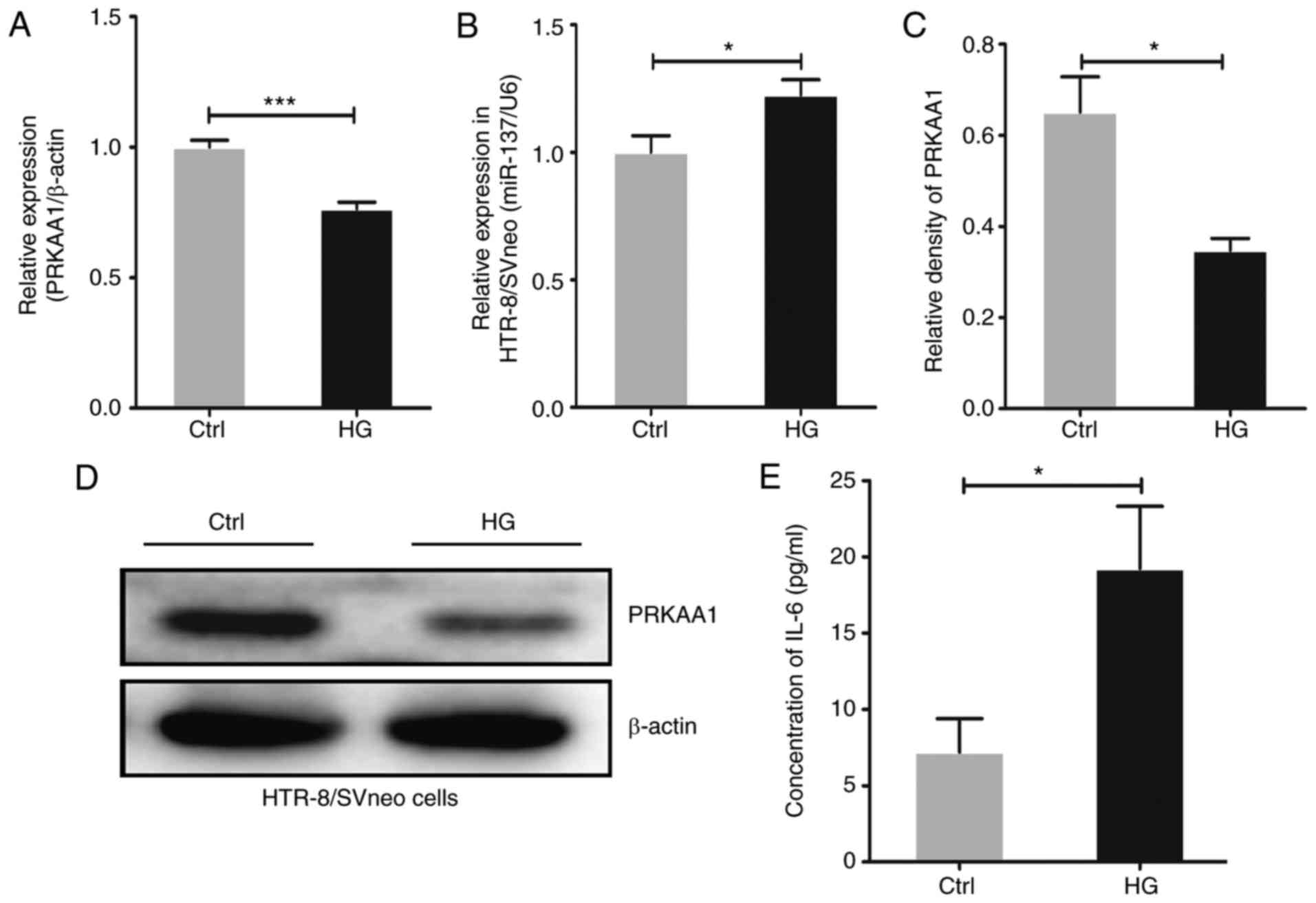 | Figure 2HG treatment suppresses the
expression of PRKAA1 and upregulates levels of miR-137 and IL-6.
HTR-8/SVneo trophoblastic cells were treated with HG (25 mmol/l)
medium for 24 h, with a control group cultured in normal medium (5
mmol/l). Expression levels of miR-137 and PRKAA1 were detected
using reverse transcription-quantitative polymerase chain reaction
analysis, with hsa-u6 and β-actin as internal controls. Protein
levels of PRKAA1 (~62 kDa) and IL-6 were measured using western
blot analysis and ELISA, respectively, and the relative density of
PRKAA1 was determined using Image Pro Plus 6.0 software. (A) HG
intervention suppressed the expression of PRKAA1 in HTR-8/SVneo
cells. (B) miR-137 expression levels were elevated in HG-exposed
HTR-8/SVneo cells. (C) Protein level of PRKAA1 was decreased in
HG-exposed HTR-8/SVneo cells. (D) Results of western blot analysis.
(E) HG treatment promoted the secretion of IL-6 in HTR-8/SVneo
cells. Data are expressed as the mean ± standard error of the mean;
statistical significance was determined using Student's t-test,
*P<0.05, ***P<0.001. HG, high glucose;
Ctrl, control; miR-137, microRNA-137; PRKAA1 protein kinase
AMP-activated catalytic subunit α1; IL-6, interleukin-6. |
Upregulating miR-137 decreases the
expression of PRKAA1 in HTR-8/SVneo cells
PRKAA1 is involved in numerous signaling pathways
and has been revealed as a target gene of miR-137 in human
umbilical vein endothelial cells (21-23). To further investigate whether the
suppressed expression of PRKAA1 is modulated by augmented miR-137
in HTR-8/SVneo cells under HG conditions, the present study used
the LV-NC and LV-miR-137 lentiviral vectors to infect HTR-8/SVneo
cells. RT-qPCR analysis was used to detect the expression levels of
PRKAA1 and the efficiency of the upregulation of miR-137, with
protein levels of PRKAA1 measured using western blot analysis. The
results, as shown in Fig. 3A,
revealed the successful infection efficiency of the lentiviral
vectors (P<0.05, P<0.01), and indicated that the upregulation
of miR-137 in HTR-8/SVneo cells decreased the expression of PRKAA1
at the gene and protein levels (Fig.
3B–D; P<0.05).
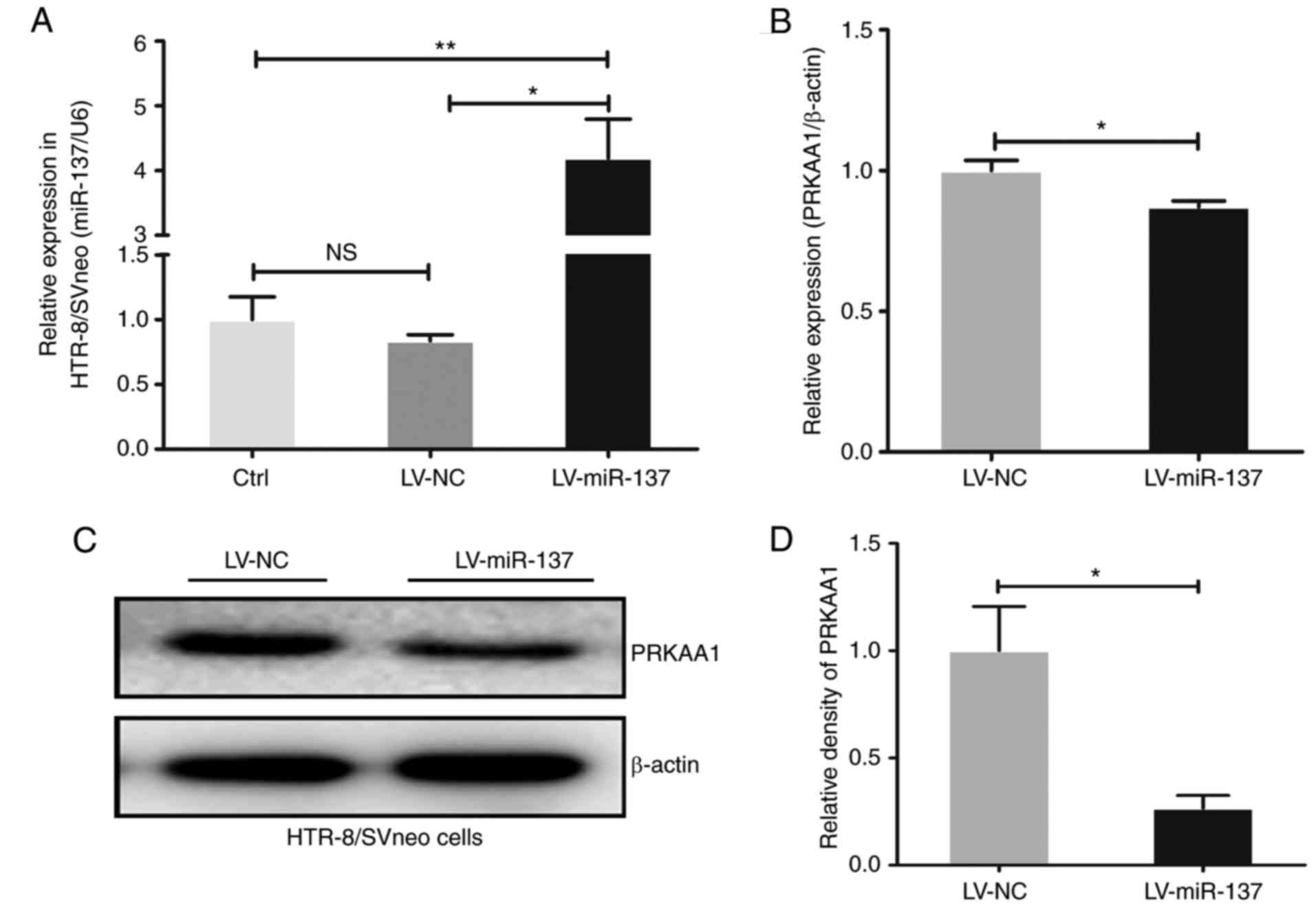 | Figure 3miR-137 upregulation decreases levels
of PRKAA1 in HTR-8/SVneo cells. HTR-8/SVneo cells were infected
with lentiviral vectors and miR-137 and PRKAA1 gene expression
levels were measured using reverse transcription-quantitative
polymerase chain reaction analysis, with hsa-u6 and β-actin as
internal controls, respectively. Protein levels of PRKAA1 (~62 kDa)
were detected by western blot analysis, and β-actin (~43 kDa) was
used as an internal control. (A) miR-137 was upregulated in
LV-miR-137 HTR-8/SVneo cells. (B) Gene expression level of PRKAA1
was downregulated in the LV-miR-137 group. (C) Western blot
analysis of PRKAA1. (D) Protein level of PRKAA1 was decreased in
miR-137-overexpressing HTR-8/SVneo cells. Data are expressed as the
mean ± standard error of the mean; statistical significance was
determined using Student's t-test, *P<0.05,
**P<0.01. Ctrl, control; NS, no significant
difference; miR-137, microRNA-137; PRKAA1 protein kinase
AMP-activated catalytic subunit α1; LV, lentiviral vector; NC,
negative control. |
HG/miR-137 elevates the expression of
IL-6 in HTR-8/SVneo cells by downregulating PRKAA1
To investigate whether the elevated secretion of
IL-6 in HG-stimulated HTR-8/SVneo cells was triggered by
miR-137/PRKAA1, the production of IL-6 at the gene and protein
levels was measured using RT-qPCR analysis and ELISA, respectively.
The results, as shown in Fig. 4A and
B, revealed that the overexpression of miR-137 upregulated the
expression of IL-6 in HTR-8/SVneo cells (P<0.05 and P<0.01).
To investigate whether PRKAA1 is involved in modulating the
expression of IL-6, different concentrations of inhibitor
(dorsomorphin) and agonist (AICAR) of PRKAA1 were used to treat the
HTR-8/SVneo cells for 24 h. The results, as shown in Fig. 4C and D, clarified that the
inhibition of PRKAA1 by dorsomorphin upregulated the expression of
IL-6, whereas the agonist of PRKAA1 caused the reverse effect
(P<0.01 and P<0.001). It was concluded that HG treatment
upregulated miR-137, which downregulated PRKKA1 and ultimately
promoted the production of IL-6 in the HTR-8/SVneo cells.
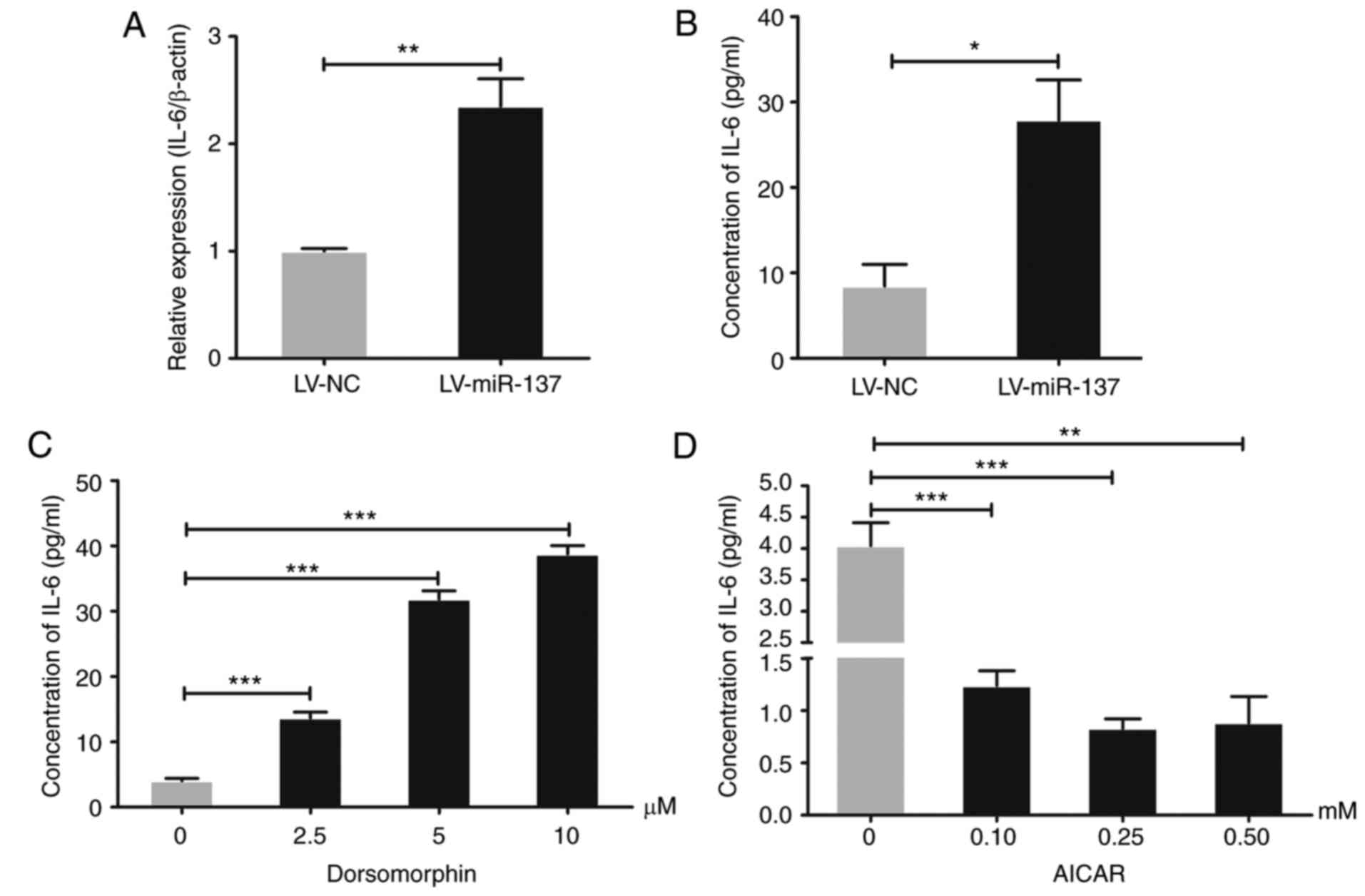 | Figure 4HG/miR-137 elevates levels of IL-6 in
HTR-8/SVneo cells by decreasing PRKAA1. Expression levels of IL-6
in LV-NC and LV-miR-137 HTR-8/SVneo cell groups were detected using
reverse transcription-quantitative polymerase chain reaction
analysis. Secretion of IL-6 into the supernatants of
miR-137-overexpressing, PRKAA1 inhibitor- and PRKAA1
agonist-treated HTR-8/SVneo cells was measured by ELISA. (A)
Overexpression of miR-137 upregulated the expression levels of IL-6
in HTR-8/SVneo cells. (B) Secretion of IL-6 was elevated in the
supernatants of miR-137-overexpressing HTR-8/SVneo cells. (C)
PRKAA1 inhibitor (dorsomorphin) promoted the production of IL-6 in
HTR-8/SVneo cells at different concentrations (2.5, 5 and 10
µM). (D) PRKAA1 agonist (AICAR; 1.10, 0.25 and 0.50 mM)
suppressed secretion of IL-6 from HTR-8/SVneo cells. Data are
expressed as the mean ± standard error of the mean; statistical
significance was determined using Student's t-test or one-way
analysis of variance, *P<0.05,
**P<0.01, ***P<0.001. miR-137,
microRNA-137; PRKAA1 protein kinase AMP-activated catalytic subunit
α1; LV, lentiviral vector; NC, negative control; IL-6,
interleukin-6. |
HG/miR-137 reduces the viability and
proliferation of HTR-8/Svneo cells
To investigate the effect of HG treatment and
subsequent upregulation of miR-137 on the HTR-8/SVneo cells, the
viability and proliferation were determined in HTR-8/SVneo cells
(LV-NC and LV-miR-137 groups), separately cultivated in normal and
HG medium. The viability and proliferation of the cells were
detected using CCK-8 and colony formation assays. The results
(Fig. 5A) and the statistical
results of the colony formation assay (Fig. 5B) revealed that the proliferation
of HTR-8/SVneo cells was reduced by the overexpression of miR-137
and/or HG treatment, compared with cells in the LV-NC group
cultivated in normal conditions (P<0.01 and P<0.001). In
addition, the results of the CCK-8 assay (Fig. 5C) demonstrated that upregulating
miR-137 in the HTR-8/SVneo cells significantly suppressed the
viability of the cells (P<0.001). These results indicated that
the HG-mediated upregulation of miR-137 reduced the viability and
proliferation of the HTR-8/SVneo cells.
miR-137 suppresses the viability of
HTR-8/SVneo cells by downregulating PRKAA1 and upregulating
IL-6
Based on the aforementioned results, it was
hypothesized that HG stimulation induced high expression levels of
miR-137, which downregulated PRKAA1 and increased IL-6. This led to
the investigation of whether the miR-137/PRKAA1/IL-6 signaling
pathway interferes with the HG-induced suppression of viability in
HTR-8/SVneo cells. The results (Fig.
6A) suggested that IL-6 suppressed the viability of HTR-8/SVneo
cells (P<0.05, P<0.01 and P<0.001), with the inhibitor of
PRKAA1 (dorsomorphin) having the same effect (P<0.001; Fig. 6B). As shown in Fig. 6C, the PRKAA1 agonist (AICAR)
promoted the viability of HTR-8/SVneo cells (P<0.05 and
P<0.01). As shown in Fig. 6D,
AICAR reversed the suppression of viability observed in HTR-8/SVneo
cells overexpressing miR-137 (P<0.05 and P<0.01). These
results suggested that HG reduced the viability and proliferation
of HTR-8/SVneo cells by upregulating miR-137 and IL-6, and
downregulating PRKAA1. IL-6 regulated by miR-137/PRKAA1
suppresses the viability and proliferation of HTR-8/SVneo
cells. In the present study, it was shown that PRKAA1 may be
regulated by miR-137 and affect the production of IL-6. It was then
hypothesized that this axis may also be involved in the HG-induced
suppression of viability and proliferation of HTR-8/SVneo cells. An
antibody of IL-6 (α-IL-6) was used to inhibit the effect of IL-6
and, as shown in Fig. 7A and B,
it was observed that α-IL-6 promoted the proliferation activity of
HTR-8/SVneo cells (P<0.05). Additionally, the results (Fig. 7C and D) suggested that the
application of α-IL-6 at different concentrations and times
facilitated the viability of the cells (P<0.05). Whether α-IL-6
was effective against the inhibitor of PRKAA1 (dorsomorphin) was
then investigated. The results (Fig.
7E) indicated that α-IL-6 reversed the viability restriction
induced by the PRKAA1 inhibitor in HTR-8/SVneo cells (P<0.05,
P<0.01 and P<0.001). Collectively, these results suggested
that HG suppressed the viability and proliferation of HTR-8/SVneo
cells via the miR-137/PRKAA1/IL-6 axis.
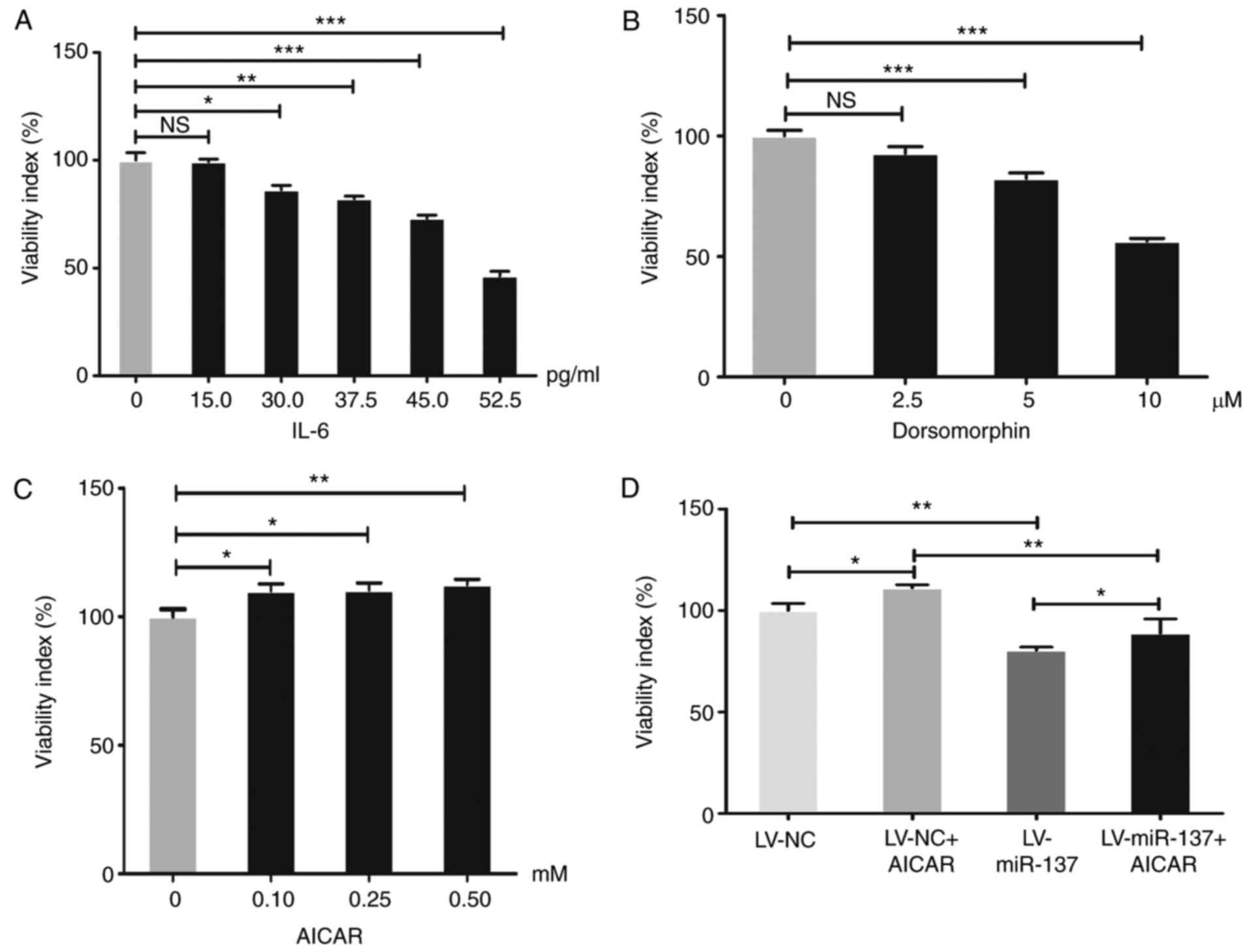 | Figure 6miR-137 suppresses cell viability of
HTR-8/SVneo cells by decreasing PRKAA1 and upregulating IL-6.
Following cell treatment with different concentrations of IL-6
(15.0, 30.0, 37.5 45.0 and 52.5 pg/ml), dorsomorphin (2.5, 5 and 10
µM) and AICAR (0.10, 0.25 and 0.50 mM) for 24 h, with
untreated cells as a control group, the viability of HTR-8/SVneo
cells was measured using a Cell Counting Kit assay. (A) Different
concentrations of IL-6 suppressed the viability of HTR-8/SVneo
cells. (B) PRKAA1 inhibitor (dorsomorphin) decreased the viability
of HTR-8/SVneo cells. (C) PRKAA1 agonist (AICAR) increased the
viability of HTR-8/SVneo cells. (D) Inhibition of viability induced
by overexpression of miR-137 in HTR-8/SVneo cells was partly
reversed by PRKAA1 agonist (AICAR, 0.5 mM). Data are presented as
the mean ± standard error of the mean; statistical significance
(P<0.05) was determined using Student's t-test or one-way
analysis of variance followed Student-Newman-Keuls test,
*P<0.05, **P<0.01,
***P<0.001. NS, no significant difference; miR-137,
microRNA-137; PRKAA1 protein kinase AMP-activated catalytic subunit
α1; IL-6, interleukin-6p; LV, lentiviral vector; NC, negative
control. |
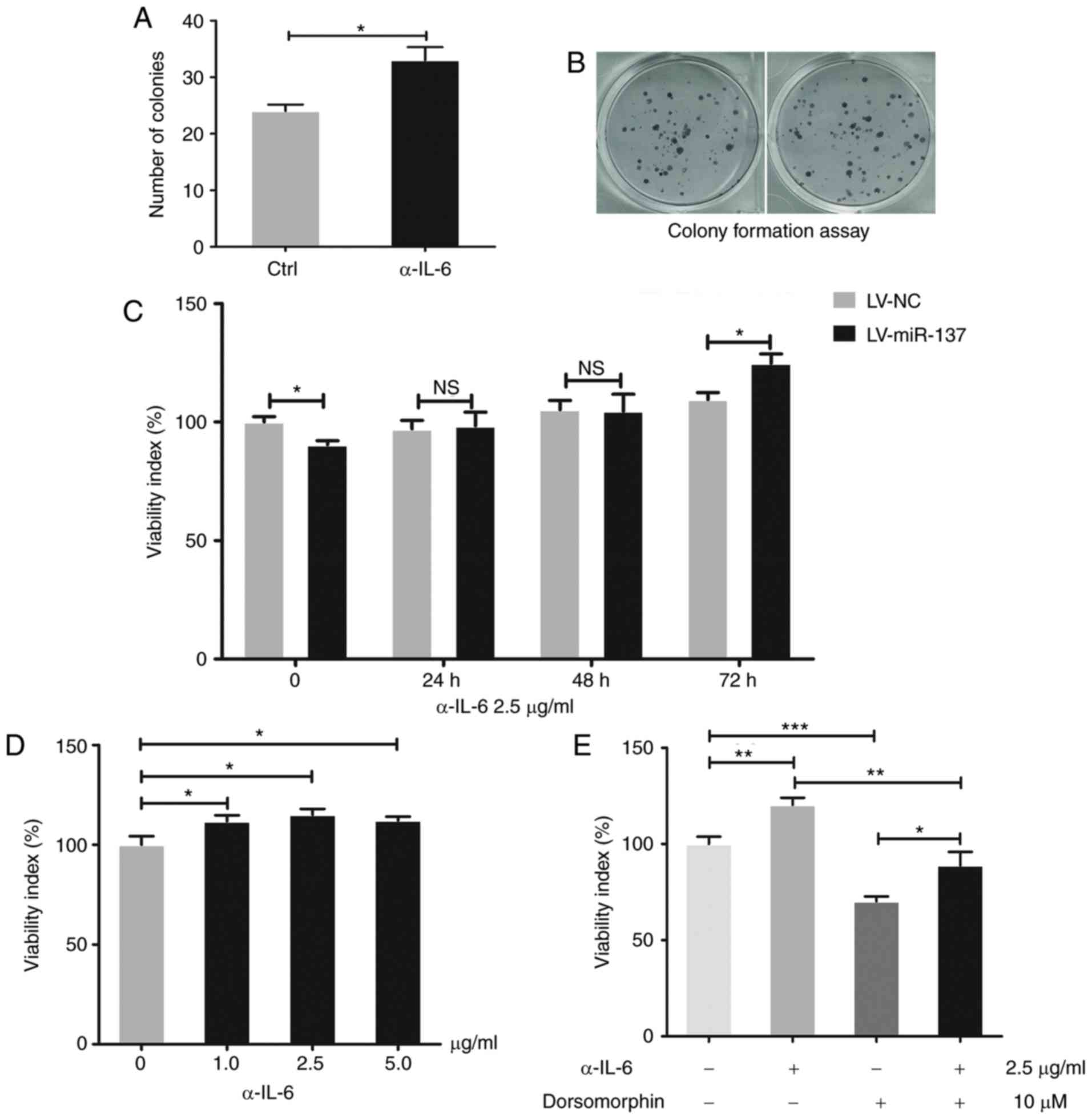 | Figure 7IL-6 regulated by miR-137/PRKAA1
suppresses cell viability and proliferation of HTR-8/SVneo cells.
Colony formation and a Cell Counting Kit-8 assays were used to
detect the proliferation and viability of HTR-8/SVneo cells,
respectively. (A) Proliferation of HTR-8/SVneo cells was enhanced
by α-IL-6 (2.5 µg/ml) treatment. (B) Images of colony
formation assay. (C) Inhibition of viability induced by the
overexpression of miR-137 in HTR-8/SVneo cells was reversed by
α-IL-6 in a time-dependent manner. (D) Treatment with α-IL-6 (1.0,
2.5 and 5.0 µg/ml) for 24 h enhanced cell viability of
HTR-8/SVneo cells. (E) α-IL-6 (2.5 µg/ml) partly reversed
the weakened viability of HTR-8/SVneo cells induced by the PRKAA1
inhibitor (dorsomorphin, 10 µM). Data are expressed as the
mean ± standard error of the mean; statistical significance was
determined using Student's t-test or one-way analysis of variance,
*P<0.05, **P<0.01,
***P<0.001. Ctrl, control; NS, no significant
difference; miR-137, microRNA-137; PRKAA1 protein kinase
AMP-activated catalytic subunit α1; IL-6, interleukin-6; α-IL-6,
antibody against IL-6; LV, lentiviral vector; NC, negative
control. |
Discussion
The results of the present study confirmed that HG
treatment contributed to the suppression of cell viability and
proliferation in the HTR-8/SVneo cell line, which is contradictory
to the most common clinical cases in which mothers with GDM give
birth to macrosomic infants and possess a larger volume of
placental tissue (24-26). It has previously been demonstrated
that HG conditions result in the mother and fetus exhibiting
'over-nutrition' and leads to overgrowth of the fetus (27). In addition, if maternal plasma
glucose levels continue to increase and remain in a severe
hyperglycemic state, cytotoxicity occurs (28). Therefore, it was hypothesized that
the suppressive effect of HG on the viability and proliferation of
trophoblast cells is associated with the concentration of glucose.
In the present study, HG medium was established with a final
glucose concentration of 25 mmol/l, in accordance with previous
studies (29,30), which is generally used in in
vitro experiments for analyzing T2DM, a type of diabetes with
symptoms of poor glycemic control and severe insulin resistance
(31). However, there is no
literature that offers an appropriate glucose concentration to suit
the conditions of light-type or pre-state of T2DM or GDM, which
occurs during pregnancy and contributes to the largest proportion
of cases of HG with adverse pregnancy outcomes (32). Due to this, the present study
investigated various cases of pregnant women with poor glycemic
control. Few studies have compared the differences in the effects
of glucose concentration in vivo and in vitro;
therefore, selecting the most suitable glucose concentration to
simulate the conditions in vivo remains a challenge and a
limitation of the present study. The use of several glucose
concentration gradients to reflect different severities of GDM in
individuals requires investigation in the future.
Previous studies have investigated the role of
PRKAA1 in diabetic/HG conditions. Firstly, PRKAA1 is aberrantly
expressed in the skeletal muscle, placenta and human sera of
individuals with GDM (33);
secondly, it is associated with HG-induced dysfunction of vascular
endothelial cells, impaired angiogenesis, cardiovascular
complications and obesity-associated insulin resistance (34); and finally, it may be regulated by
the diabetes drug metformin (35). Therefore, it was hypothesized that
PRKAA1 may also be involved in the insulin signaling pathway and
insulin resistance of HTR-8/SVneo cells, further contributing to
the pathological changes of trophoblast cells. It has been reported
that a reduction of PRKAA1 may disrupt cellular metabolism in
trophoblast cells (36), and that
the activation of PRKAA1 promotes maintenance of the
utero-placental bloodstream during hypoxic pregnancy (34). The direct effects of decreased
PRKAA1 on the proliferation, migration and invasiveness of
trophoblast cells have not been investigated extensively
previously. To the best of our knowledge, the present study is the
first to demonstrate that PRKAA1 may be involved in modulating the
viability and proliferation of HTR-8/SVneo cells under HG
conditions, and provides a theoretical foundation for future
clinical treatment of patients with GDM. However, the present study
had various limitations, including a lack of investigation into the
role of phosphorylated PRKAA1, which may be an important factor
involved in the pathology of the placenta in a gestational diabetic
condition.
miR-137 has previously been reported to contribute
to the progression of preeclampsia and GDM (13,14), being vital in regulating vascular
endothelial and trophoblast cells, involved in various biological
processes and HG-induced oxidative stress injury, and a potential
biomarker for monitoring the severity of diseases and long-term
risk of metabolic disorders. Various studies have investigated the
association between gestational diabetic conditions and levels of
miR-137, and it has been revealed that HG gives rise to aberrant
expression of miR-137 in various cells and tissues; however, the
specific underlying mechanisms involved in this process remain to
be elucidated. Certain molecules are involved in regulating miRNAs,
and these may also be targeted by miRNAs, which form a loop and
radically promote the progression of pathological changes (37). In addition to the abnormal
expression of miR-137, methylation of the miR-137 promoter may also
contribute to the occurrence and progression of diseases (38,39). Regarding upstream regulatory
molecules of miR-137, Forkhead box D3 and high-mobility group
AT-hook 1 have been reported to activate the transcription of
miR-137 via directly binding to its promoter (40). The mechanism underlying the
upregulation of miR-137 under HG conditions remains to be
elucidated, although disruption of the miR-137 promoter region may
account for this change. Previously demonstrated roles of miR-137
are closely associated with its target genes (41); in the present study, PRKAA1 was
significantly downregulated by miR-137, and it is possible that
various other unidentified genes are involved in suppressing the
viability and proliferation of HTR-8/SVneo cells.
According to previous studies, the role of PRKAA1 in
regulating IL-6 is variable in different types of cells. Tang et
al (42) demonstrated that an
inhibitor of PRKAA1 suppressed adiponectin-induced production of
IL-6 in human rheumatoid arthritis synovial and osteoarthritis
synovial fibroblasts. Lihn et al (43) observed that an agonist of PRKAA1
decreased levels of IL-6 in adipose tissues, and was consistent
with the results of Lim et al (17), which suggested that the PRKAA1
activator AICAR reduced levels of IL-6 in primary amnion cells.
These distinctions may be attributed to the various biological
functions of different cells, and the role of PRKAA1 in regulating
IL-6 in trophoblast cells has received limited investigation. The
present study demonstrated that the inhibitor of PRKAA1,
dorsomorphin, significantly upregulated the expression of IL-6 in
HTR-8/SVneo cells, whereas the agonist of PRKAA1, AICAR, exhibited
the opposite effect. Based on knowledge of existing signaling
pathways associated with PRKAA1, it was established that IL-6 is
not a direct target, and the mechanism underlying the
PRKAA1-induced regulation of the expression of IL-6 through
intermediate molecules in HTR-8/SVneo cells remains to be fully
elucidated. Increased levels of IL-6 have been observed in the
plasma and various tissues of patients with GDM, which promotes not
only low-grade inflammatory reaction, but also disease progression
(21). It has previously been
demonstrated that IL-6 inhibitor promotes the viability of
pancreatic β-cells (44), whereas
elevated IL-6 induces obesity-related insulin resistance (45), which serves as the etiology for
the development of impaired glucose tolerance. Apoptosis and
proliferation contribute to the viability of cells, and the present
study only clarified that restricted proliferation activity
resulted in the decreased viability of HTR-8/SVneo cells; however,
the underlying mechanism remains to be elucidated. IL-6 may be
involved in maldevelopment of the placenta through suppressing the
viability and proliferation of trophoblast cells; the dysfunction
of vascular endothelial cells and disrupted angiogenesis induced by
IL-6 may also contribute to the pathology (46). Notably, upstream or downstream
molecules of IL-6 may act as ideal therapeutic targets for
intervention of GDM, particularly if the expression levels of these
molecules are associated with the severity of diseases.
In conclusion, as shown in Fig. 8, the HG of a gestational diabetic
condition suppressed the viability and proliferation of HTR-8/SVneo
cells through the miR-137/PRKAA1/IL-6 axis, and this may contribute
to the pathology of trophoblast cells during the diabetic period.
Whether this leads to maldevelopment of the placenta and adverse
pregnancy outcomes requires verification in vivo through
animal experiments. The present study aimed to provide an
underlying mechanism for the dysfunction of trophoblast cells in
conditions of hyperglycemia, and to provide a theoretical
foundation for future therapeutic treatments for mothers with
GDM.
Acknowledgments
The authors would like to thank Professor Da-Jin Li
of Fudan University (Shanghai, China) for his assistance in study
design.
Funding
This study was supported by the Natural Science
Foundation of Shanghai (grant no. 12ZR1422200) and the Research
Fund of Shanghai Jiao Tong University Affiliated Sixth People's
Hospital (grant no. LYZY-0053).
Availability of data and materials
The datasets used and/or analyzed during the current
study are available from the corresponding author on reasonable
request.
Authors' contributions
HL conceptualized the study design. HP acquired the
data and drafted the manuscript. ML contributed to the study design
and revised the manuscript.
Ethics approval and consent to
participate
The present study was approved by the Ethics
Committee of Shanghai Jiao Tong University Affiliated Sixth
People's Hospital. All participants provided informed consent.
Consent for publication
All authors reviewed multiple drafts of the paper
and approved the final manuscript for publication.
Competing interests
The authors declare that they have no competing
interests.
References
|
1
|
Kleinwechter H and Demandt N: Diabetes in
pregnancy-type 1/type 2 diabetes mellitus and gestational diabetes
mellitus. Dtsch Med Wochenschr. 141:1296–1303. 2016.In German.
PubMed/NCBI
|
|
2
|
Bánhidy F, Acs N, Puhó EH and Czeizel AE:
Congenital abnormalities in the offspring of pregnant women with
type 1, type 2 and gestational diabetes mellitus: A
population-based case-control study. Congenit Anom. 50:115–121.
2010. View Article : Google Scholar
|
|
3
|
Callec R, Perdriolle-Galet E, Sery GA and
Morel O: Type 2 diabetes in pregnancy: Rates of fetal malformations
and level of preconception care. J Obstet Gynaecol. 34:648–649.
2014. View Article : Google Scholar : PubMed/NCBI
|
|
4
|
Kaiser J: Gearing up for a closer look at
the human placenta. Science. 344:10732014. View Article : Google Scholar
|
|
5
|
Zong S, Li C, Luo C, Zhao X, Liu C, Wang
K, Jia W, Bai M, Yin M, Bao S, et al: Dysregulated expression of
IDO may cause unexplained recurrent spontaneous abortion through
suppression of trophoblast cell proliferation and migration. Sci
Rep. 27:199162016. View Article : Google Scholar
|
|
6
|
Tian FJ, Qin CM, Li XC, Wu F, Liu XR, Xu
WM and Lin Y: Decreased stathmin-1 expression inhibits trophoblast
proliferation and invasion and is associated with recurrent
miscarriage. Am J Pathol. 185:2709–2721. 2015. View Article : Google Scholar : PubMed/NCBI
|
|
7
|
Liong S and Lappas M: Activation of AMPK
improves inflammation and insulin resistance in adipose tissue and
skeletal muscle from pregnant women. J Physiol Biochem. 71:703–717.
2015. View Article : Google Scholar : PubMed/NCBI
|
|
8
|
Li J and Li J, Wei T and Li J:
Down-regulation of MicroRNA-137 improves high glucose induced
oxidative stress injury in human umbilical vein endothelial cells
by up-regulation of AMPKα1. Cell Physiol Biochem. 39:847–859. 2016.
View Article : Google Scholar
|
|
9
|
Yao G, Zhang Y, Wang D, Yang R, Sang H,
Han L, Zhu Y, Lu Y, Tan Y and Shang Z: GDM-induced macrosomia is
reversed by Cav-1 via AMPK-mediated fatty acid transport and
GLUT1-mediated glucose transport in placenta. PLoS One.
12:e01704902017. View Article : Google Scholar : PubMed/NCBI
|
|
10
|
Chen H, Lan HY, Roukos DH and Cho WC:
Application of microRNAs in diabetes mellitus. J Endocrinol.
222:R1–R10. 2014. View Article : Google Scholar : PubMed/NCBI
|
|
11
|
Haertle L, El Hajj N, Dittrich M, Müller
T, Nanda I, Lehnen H and Haaf T: Epigenetic signatures of
gestational diabetes mellitus on cord blood methylation. Clin
Epigenetics. 9:282017. View Article : Google Scholar : PubMed/NCBI
|
|
12
|
Ornoy A, Reece EA, Pavlinkova G, Kappen C
and Miller RK: Effect of maternal diabetes on the embryo, fetus,
and children: Congenital anomalies, geneticand epigenetic changes
and developmental outcomes. Birth Defects Res C Embryo Today.
105:53–72. 2015. View Article : Google Scholar : PubMed/NCBI
|
|
13
|
Li J, Song L, Zhou L, Wu J, Sheng C, Chen
H, Liu Y, Gao S and Huang W: A MicroRNA signature in gestational
diabetes mellitus associated with risk of macrosomia. Cell Physiol
Biochem. 37:243–252. 2015. View Article : Google Scholar : PubMed/NCBI
|
|
14
|
Lu TM, Lu W and Zhao LJ: MicroRNA-137
affects proliferation and migration of placenta trophoblast cells
in preeclampsia by targeting ERRα. Reprod Sci. pii:
1933719116650754. 2016.
|
|
15
|
Lappas M: Double stranded viral RNA
induces inflammation and insulin resistance in skeletal muscle from
pregnant women in vitro. Metabolism. 64:642–653. 2015. View Article : Google Scholar : PubMed/NCBI
|
|
16
|
Kim SY, Jeong S, Jung E, Baik KH, Chang
MH, Kim SA, Shim JH, Chun E and Lee KY: AMP-activated protein
kinase-α1 as an activating kinase of TGF-β-activated kinase 1 has a
key role in inflammatory signals. Cell Death Dis. 3:e3572012.
View Article : Google Scholar
|
|
17
|
Lim R, Barker G and Lappas M: Activation
of AMPK in human fetal membranes alleviates infection-induced
expression of pro-inflammatory and pro-labour mediators. Placenta.
36:454–462. 2015. View Article : Google Scholar : PubMed/NCBI
|
|
18
|
Huang L, Chiang SH, Hsueh CH, Liang YJ and
Chen YJ: Lai LP. Metformin inhibits TNF-alpha-induced Ikappa-B
kinase phosphorylation, IkappaB-alpha degradation and IL-6
production in endothelial cells through I3K-dependent AMPK
phosphorylation. Int J Cardiol. 134:169–175. 2009. View Article : Google Scholar
|
|
19
|
American Diabetes Association: Diagnosis
and classification of diabetes mellitus: Diabetes Care. 35(Suppl
1): S64–S71. 2012. View Article : Google Scholar
|
|
20
|
Livak KJ and Schmittgen TD: Analysis of
relative gene expression data using real-time quantitative PCR and
the 2−ΔΔC T method. Methods. 25:402–408. 2001.
View Article : Google Scholar
|
|
21
|
Daniele G, Guardado Mendoza R, Winnier D,
Fiorentino TV, Pengou Z, Cornell J, Andreozzi F, Jenkinson C,
Cersosimo E, Federici M, et al: The inflammatory status score
including IL-6, TNF-α, osteopontin, fractalkine, MCP-1 and
adiponectin underlies whole-body insulin resistance and
hyperglycemia in type 2 diabetes mellitus. Acta Diabetol.
51:123–131. 2014. View Article : Google Scholar
|
|
22
|
Bigham AW, Julian CG, Wilson MJ, Vargas E,
Browne VA, Shriver MD and Moore LG: Maternal RKAA1 and EDNRA
genotypes are associated with birth weight, and RKAA1 with uterine
artery diameter and metabolic homeostasis at high altitude. Physiol
Genomics. 46:687–697. 2014. View Article : Google Scholar : PubMed/NCBI
|
|
23
|
He C, Li H, Viollet B, Zou MH and Xie Z:
AMPK suppresses vascular inflammation in vivo by inhibiting signal
transducer and activator of transcription-1. Diabetes.
64:4285–4297. 2015. View Article : Google Scholar : PubMed/NCBI
|
|
24
|
Visiedo F, Bugatto F, Sánchez V,
Cózar-Castellano I, Bartha JL and Perdomo G: High glucose levels
reduce fatty acid oxidation and increase triglyceride accumulation
in human placenta. Am J Physiol Endocrinol Metab. 305:E205–E212.
2013. View Article : Google Scholar : PubMed/NCBI
|
|
25
|
Wang LF, Wang HJ, Ao D, Liu Z, Wang Y and
Yang HX: Influence of pre-pregnancy obesity on the development of
macrosomia and large for gestational age in women with or without
gestational diabetes mellitus in Chinese population. J Perinatol.
35:985–990. 2015. View Article : Google Scholar : PubMed/NCBI
|
|
26
|
Jarmuzek P, Wielgos M and Bomba-Opon D:
Placental pathologic changes in gestational diabetes mellitus.
Neuro Endocrinol Lett. 36:101–105. 2015.PubMed/NCBI
|
|
27
|
Leng J, Li W, Zhang S, Liu H, Wang L, Liu
G, Li N, Redman LM, Baccarelli AA, Hou L and Hu G: GDM women's
pre-pregnancy overweight/obesity and gestational weight gain on
offspring overweight status. PLoS One. 10:e01295362015. View Article : Google Scholar : PubMed/NCBI
|
|
28
|
Sedlic F, Muravyeva MY, Sepac A, Sedlic M,
Williams AM, Yang M, Bai X and Bosnjak ZJ: Targeted modification of
mitochondrial ROS production converts high glucose-induced
cytotoxicity to cytoprotection: Effects on anesthetic
preconditioning. J Cell Physiol. 232:216–224. 2017. View Article : Google Scholar
|
|
29
|
Kuricová K, Pácal L, Šoupal J, Prázný M
and Kaňková K: Effect of glucose variability on pathways associated
with glucotoxicity in diabetes: Evaluation of a novel in vitro
experimental approach. Diabetes Res Clin Pract. 114:1–8. 2016.
View Article : Google Scholar : PubMed/NCBI
|
|
30
|
Liu J, Chen S, Ren W, Liu J, Yang P, Chen
Z, Zhang Q and Yang F: Lipopolysaccharide-induced suppression of
periodontal ligament cell proliferation and apoptosis are
strengthened under high glucose conditions. Arch Oral Biol.
79:70–76. 2017. View Article : Google Scholar : PubMed/NCBI
|
|
31
|
Abdallah AM, Alves BC, Gehrke FS, Sant'
Ana AV, Azzalis LA, Junqueira VB, Adami F, Pereira EC and Fonseca
FL: Inability of turbidimetry method in detecting glycated
hemoglobin to select diabetes mellitus patients according to their
concentrations of blood glucose levels. J Clin Lab Anal.
29:312–316. 2015. View Article : Google Scholar
|
|
32
|
Pedersen ML, Olesen J, Jørgensen ME and
Damm P: Gestational diabetes mellitus in Greenland: A national
study of prevalence and testing efficacy. Int J Circumpolar Health.
75:321672016. View Article : Google Scholar : PubMed/NCBI
|
|
33
|
Wojtaszewski JF, Birk JB, Frøsig C, Holten
M, Pilegaard H and Dela F: 5′AMP activated protein kinase
expression in human skeletal muscle: Effects of strength training
and type 2 diabetes. J Physiol. 564:563–573. 2005. View Article : Google Scholar : PubMed/NCBI
|
|
34
|
Song YM, Lee YH, Kim JW, Ham DS, Kang ES,
Cha BS, Lee HC and Lee BW: Metformin alleviates hepatosteatosis by
restoring SIRT1-mediated autophagy induction via an AMP-activated
protein kinase-independent pathway. Autophagy. 11:46–59. 2015.
View Article : Google Scholar :
|
|
35
|
Waker CA, Albers RE, Pye RL, Doliboa SR,
Wyatt CN, Brown TL and Mayes DA: AMPK knockdown in placental
labyrinthine progenitor cells results in restriction of critical
energy resources and terminal differentiation failure. Stem Cells
Dev. 26:808–817. 2017. View Article : Google Scholar : PubMed/NCBI
|
|
36
|
Zhang L, Han YJ, Zhang X, Wang X, Bao B,
Qu W and Liu J: Luteolin reduces obesity-associated insulin
resistance in mice by activating ampkα1 signaling in adipose tissue
macrophages. Diabetologia. 59:2219–2228. 2016. View Article : Google Scholar : PubMed/NCBI
|
|
37
|
Floris I, Descamps B, Vardeu A, Mitić T,
Posadino AM, Shantikumar S, Sala-Newby G, Capobianco G, Mangialardi
G, Howard L, et al: Gestational diabetes mellitus impairs fetal
endothelial cell functions through a mechanism involving
microRNA-101 and histone methyltransferase enhancer of zester
homolog-2. Arterioscler Thromb Vasc Biol. 35:664–674. 2015.
View Article : Google Scholar : PubMed/NCBI
|
|
38
|
Dang J, Bian YQ, Sun JY, Chen F, Dong GY,
Liu Q, Wang XW, Kjems J, Gao S and Wang QT: MicroRNA-137 promoter
methylation in oral lichen planus and oral squamous cell carcinoma.
J Oral Pathol Med. 42:315–321. 2013. View Article : Google Scholar
|
|
39
|
Langevin SM, Stone RA, Bunker CH,
Lyons-Weiler MA, LaFramboise WA, Kelly L, Seethala RR, Grandis JR,
Sobol RW and Taioli E: MicroRNA-137 promoter methylation is
associated with poorer overall survival in patients with squamous
cell carcinoma of the head and neck. Cancer. 117:1454–1462. 2011.
View Article : Google Scholar : PubMed/NCBI
|
|
40
|
Liu LL, Lu SX, Li M, Li LZ, Fu J, Hu W,
Yang YZ, Luo RZ, Zhang CZ and Yun JP: FoxD3-regulated microRNA-137
suppresses tumour growth and metastasis in human hepatocellular
carcinoma by targeting AKT2. Oncotarget. 5:5113–5124. 2014.
View Article : Google Scholar : PubMed/NCBI
|
|
41
|
Han F, Wang S, Chang Y, Li C, Yang J, Han
Z, Chang B, Sun B and Chen L: Triptolide prevents extracellular
matrix accumulation in experimental diabetic kidney disease by
targeting microRNA-137/Notch1 pathway. J Cell Physiol.
233:2225–2237. 2018. View Article : Google Scholar
|
|
42
|
Tang CH, Chiu YC, Tan TW, Yang RS and Fu
WM: Adiponectin enhances IL-6 production in human synovial
fibroblast via an AdipoR1 receptor, AMPK, 38 and NF-kappa B
pathway. J Immunol. 179:5483–5492. 2007. View Article : Google Scholar : PubMed/NCBI
|
|
43
|
Lihn AS, Jessen N, Pedersen SB, Lund S and
Richelsen B: AICAR stimulates adiponectin and inhibits cytokines in
adipose tissue. Biochem Biophys Res Commun. 316:853–858. 2004.
View Article : Google Scholar : PubMed/NCBI
|
|
44
|
Paula FM, Leite NC, Vanzela EC, Kurauti
MA, Freitas-Dias R, Carneiro EM, Boschero AC and Zoppi CC: Exercise
increases pancreatic β-cell viability in a model of type 1 diabetes
through IL-6 signaling. FASEB J. 29:1805–1816. 2015. View Article : Google Scholar : PubMed/NCBI
|
|
45
|
Almuraikhy S, Kafienah W, Bashah M, Diboun
I, Jaganjac M, Al-Khelaifi F, Abdesselem H, Mazloum NA, Alsayrafi
M, Mohamed-Ali V and Elrayess MA: Interleukin-6 induces impairment
in human subcutaneous adipogenesis in obesity-associated insulin
resistance. Diabetologia. 59:2406–2416. 2016. View Article : Google Scholar : PubMed/NCBI
|
|
46
|
Qu D, Liu J, Lau CW and Huang Y: IL-6 in
diabetes and cardiovascular complications. Br J Pharmacol.
171:3595–3603. 2014. View Article : Google Scholar : PubMed/NCBI
|















